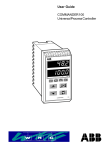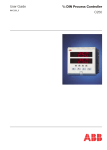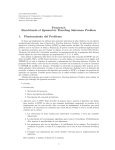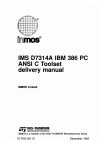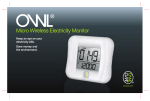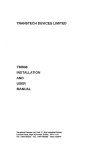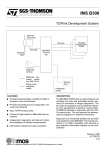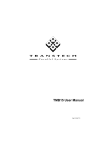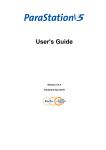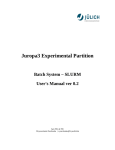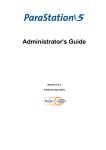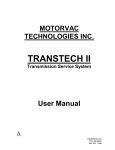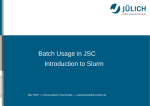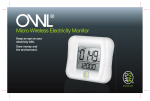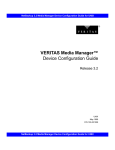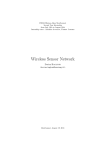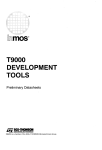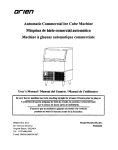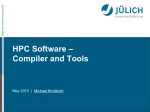Download MatchBox User Manual
Transcript
MatchBox User Manual Ref: MBX M 711 Document reference number MBX M 711. Copyright 1997 Transtech Parallel Systems. This publication is protected by Copyright Law, with all rights reserved. No part of this publication may be reproduced, stored in a retrieval system, translated, transcribed, or transmitted, in any form, or by any means manual, electric, electronic, mechanical, chemical, optical or otherwise, without prior written permission from Transtech Parallel Systems. Transtech reserves the right to alter specifications without notice, in line with its policy of continuous development. Transtech cannot accept responsibility to any third party for loss or damage arising out of the use of this information. Transtech acknowledges all registered trademarks. Transtech Parallel Systems Corp 20 Thornwood Drive Ithaca NY 14850-1263 USA Transtech Parallel Systems Ltd 17-19 Manor Court Yard Hughenden Avenue High Wycombe Bucks, HP13 5RE United Kingdom tel: 607 257 6502 fax: 607 257 3980 tel: +44 (0) 1494 464303 fax: +44 (0) 1494 463686 [email protected] http://www.transtech.com [email protected] http://www.transtech.co.uk Table of Contents Chapter 1 Introduction 1 1.1 Manual Conventions ............................................................... 1 Chapter 2 Hardware Installation 3 2.1 Power Connection ................................................................... 3 2.2 SCSI Connection ..................................................................... 4 2.2.1 SCSI Cabling and Termination ...................................... 5 2.2.2 MatchBox SCSI Id ......................................................... 5 2.3 PARAstation Connection ......................................................... 7 2.3.1 D Connector .................................................................. 7 Chapter 3 Software Installation 11 3.1 Sun SPARCstation ................................................................ 11 3.2 Password .............................................................................. 12 3.3 Environment .......................................................................... 12 3.4 Connection Database ............................................................ 13 3.5 Rebooting .............................................................................. 13 Chapter 4 Host Link Names 15 4.1 Connection Database ............................................................ 15 Chapter 5 Iserver 17 5.1 Source ................................................................................... 17 5.2 Iserver Libraries .................................................................... 17 5.3 Reference Section ................................................................. 19 iserver................................................................................... 19 hostmux ................................................................................ 21 iocache ................................................................................. 25 genio ..................................................................................... 27 MBX M 711 MatchBox User Manual i Chapter 6 Check Utilities 31 6.1 Reference ..............................................................................32 check..................................................................................... 32 ckmon ...................................................................................34 ftest .......................................................................................36 load .......................................................................................37 mtest .....................................................................................38 Chapter 7 Aserver 41 Chapter 8 Configuration 43 8.1 Manual Page ..........................................................................44 tspconf .................................................................................. 44 Chapter 9 TSP Library 45 tsp_analyse........................................................................... 45 tsp_close ...............................................................................47 tsp_error ................................................................................48 tsp_mknod ............................................................................49 tsp_open ...............................................................................50 tsp_protocol ..........................................................................51 tsp_read ................................................................................53 tsp_read_config ....................................................................54 tsp_reset ...............................................................................55 tsp_reset_config ....................................................................56 tsp_write ................................................................................57 tsp_write_config ....................................................................58 Appendix A SCSI Reference 59 A.1 Host Links ..............................................................................59 A.2 Configuration Link .................................................................60 A.3 Subsystems ...........................................................................60 A.4 Miscellaneous ........................................................................60 A.5 SCSI Commands ...................................................................61 TEST UNIT READY ..............................................................62 READ FLAGS .......................................................................63 REQUEST SENSE ...............................................................64 WRITE FLAGS ......................................................................66 ii MatchBox User Manual MBX M 711 RECEIVE .............................................................................. 68 READ CONFIG .................................................................... 70 SEND ................................................................................... 71 WRITE CONFIG ................................................................... 72 INQUIRY .............................................................................. 73 SEND DIAGNOSTIC ............................................................ 74 WRITE BUFFER .................................................................. 75 READ BUFFER .................................................................... 76 Index MBX M 711 77 MatchBox User Manual iii iv MatchBox User Manual MBX M 711 Introduction Chapter 1 Introduction The Transtech MatchBox is primarily designed to interface the SCSI port of a workstation to Transtech PARAstation systems. However, the MatchBox can equally be used to interface to a wide range of other Inmos Transputer based systems. On multi-user workstations, up to four users can concurrently access the PARAstation resources per MatchBox. In addition to these four host links, a fifth configuration link is implemented which allows the network configuration of the PARAstation to be set. When using a Transtech PARAstation system, this manual should be read in conjunction with the PARAstation User Manual. Please note that a password is required to use the MatchBox with a UNIX host. See section 3.2 on page 12 for details. Passwords can be obtained from your local Transtech office. 1.1 Manual Conventions Commands, filenames e.t.c are printed in courier font. Command lines which are to be typed at the Unix prompt are printed thus: % command except for commands which are required to be run by root or superuser which are printed thus: # command The contents of files or the output of programs is printed thus: First line Second line MBX M 711 MatchBox User Manual 1 Manual Conventions Where relative filenames or directory names are quoted (i.e. filenames not starting with a ‘/’) then these should be interpreted as being relative to the software installation directory. See the relevant software installation section for details of the installation directory. 2 MatchBox User Manual MBX M 711 Hardware Installation Chapter 2 Hardware Installation The Transtech MatchBox needs to be connected to: • The power supply. • The host workstation SCSI bus. • The Transtech PARAstation. The MatchBox connectors and switches are shown in figure 1, which is a rear view of the MatchBox. Power Switch Power Connector 37 Way D Connector Fan SCSI Connectors SCSI Id Switch Figure 1. MatchBox Back Panel 2.1 Power Connection Mains power at the correct voltage needs to be supplied to the workstation, the MatchBox and the PARAstation. The MatchBox takes AC voltages in the range 90V to 260V. MBX M 711 MatchBox User Manual 3 SCSI Connection For reliable operation, ensure that the workstation, the MatchBox, the PARAstation and any other peripherals are all powered from the same mains circuit. 2.2 SCSI Connection The MatchBox is connected to the computer workstation by the SCSI bus. This requires you to: • Choose and set the MatchBox SCSI id. • Connect the MatchBox to the host workstation SCSI port and other SCSI devices (if any). • Terminate the SCSI bus. Shutdown and switch off the workstation and any connected SCSI peripherals before connecting the MatchBox. Most UNIX workstations have a built in SCSI port accessible from the rear. A typical workstation SCSI setup is illustrated in figure 2 where the workstation has an internal disk and the MatchBox is the only external SCSI peripheral. Alternatively, it is possible to have more than one SCSI adapter installed in the workstation and have the MatchBox on a different SCSI bus from other SCSI peripherals. Workstation MatchBox SCSI Terminator SCSI Adapter Internal Disk SCSI Cable Figure 2. SCSI Connections 4 MatchBox User Manual MBX M 711 Hardware Installation 2.2.1 SCSI Cabling and Termination Most SCSI peripherals, including the MatchBox, have two SCSI connectors. This allows multiple SCSI peripherals to be connected to one workstation. It does not matter which MatchBox SCSI connector is used to connect to the workstation and which is used to connect to other SCSI peripherals. Problems can occur if the SCSI cables are of poor quality or if their total length is too big. The shorter the SCSI bus cables the better. The SCSI-2 specification requires that the total cable length (including internal cables) is no greater than 6m. As a rule of thumb, do not allow external cabling to exceed 3m. The SCSI bus must be terminated using a suitable terminator at both ends. The end internal to the workstation will normally be terminated on the SCSI adapter. If the MatchBox is the last external SCSI peripheral, fit the supplied terminator to the unused MatchBox SCSI connector. If a SCSI peripheral is used which has internal SCSI bus termination, then this must be the last device on the SCSI bus. 2.2.2 MatchBox SCSI Id The SCSI id of the MatchBox is set using a switch on the underside of the box as shown in figure 3. Decrement Button 5 SCSI Id Increment Button Figure 3. SCSI Id Switch A ballpoint pen or other suitable object can be used to increase or decrease the value by one until the required value is set as required. You need to use an unused value between 0 and 7. A SCSI id of 5 is often suitable. Each internal and external peripheral connected to the SCSI bus (including the workstation SCSI adapter) has a unique id between 0 and 7. The SCSI bus will fail to operate if more than one device has MBX M 711 MatchBox User Manual 5 SCSI Connection the same SCSI id. To choose an id for the MatchBox you need to know the SCSI ids of all of the other devices already on the SCSI bus. 2.2.2.1 Sun SPARCstations On Sun SPARCstations there is a monitor command probe-scsi which can be used to determine the ids of peripherals connected to the SCSI bus: 1. If any external SCSI peripherals are used, ensure that they are properly connected to the Sun and the SCSI bus is terminated. 2. Switch on the Sun monitor and external SCSI peripherals. 3. Switch on the Sun workstation. 4. When the Sun logo appears and the monitor tests start, hold down the L1 key and press the A key. This stops the tests and brings up the monitor prompt. 5. If the monitor prompt is ‘>’ then type n and press Return. 6. At the ok prompt type probe-scsi and press Return. A list of SCSI target devices like the following is produced: Target 1 Unit 0 Disk MAXTOR LXT-231S 4.18 This shows that there is a disk with SCSI id 1 with one logical unit. In fact it is a Maxtor LXT-231S disk (revision 4.18) which is installed internally in the Sun. The Sun workstation SCSI adapter is 7 by default, thus in this case a suitable choice for the MatchBox SCSI id is 5. When a MatchBox is correctly connected to the host SCSI bus, for example with SCSI id 5, the probe-scsi command will additionally display messages similar to: Target 5 Unit 0 Unit 1 Unit 2 Unit 3 Unit 4 Unit 5 6 Processor Processor Processor Processor Processor Processor MatchBox User Manual TRANST TRANST TRANST TRANST TRANST TRANST MatchBox MatchBox MatchBox MatchBox MatchBox MatchBox 1.00 1.00 1.00 1.00 1.00 1.00 MBX M 711 Hardware Installation Unit 6 Unit 7 Processor Processor TRANST TRANST MatchBox MatchBox 1.00 1.00 showing the eight MatchBox logical units. At this point you can safely switch off the Sun. 2.3 PARAstation Connection The Transtech MatchBox is connected to the PARAstation by a cable which connects to 37 way D connector on both systems as shown in figure 4. Main UP Connector MatchBox PARAstation 37 Way Cable Figure 4. PARAstation Connection 2.3.1 D Connector The connection between the MatchBox and the PARAstation, or to other external Transputer systems, is made via the MatchBox 37 way D connector. The pin-out for this is shown in figure 5. MBX M 711 MatchBox User Manual 7 PARAstation Connection Config Reset: Pin 20 +5V: Pin 21 Link0 In: Pin 22 Link1 In: Pin 23 Link2 Out: Pin 24 Link3 Out: Pin 25 Config Out: Pin 26 Ground: Pin 27 N/C: Pin 28 N/C: Pin 29 N/C: Pin 30 NotReset0: Pin 31 NotAnalyse0: Pin 32 NotReset1: Pin 33 NotError1: Pin 34 NotError2: Pin 35 +5V: Pin 36 NotAnalyse3: Pin 37 o o o o o o o o o o o o o o o o o o o o o o o o o o o o o o o o o o o o o Pin 1: Ground Pin 2: N/C Pin 3: Link0 Out Pin 4: Link1 Out Pin 5: Ground Pin 6: Link2 In Pin 7: Link3 In Pin 8: Config In Pin 9: N/C Pin 10: N/C Pin 11: N/C Pin 12: Ground Pin 13: NotError0 Pin 14: +5V Pin 15: NotAnalyse1 Pin 16: NotReset2 Pin 17: NotAnalyse2 Pin 18: NotReset3 Pin 19: NotError3 Figure 5. 37 Way D Connector A Break-out board is supplied which plugs into the 37 way D connector and has a number of link headers which can be used to connect the MatchBox to Transputer networks using standard Inmos link cables. The connectors available on the Break-out board are shown in figure 6. 8 MatchBox User Manual MBX M 711 Hardware Installation Config Reset Link 0 Link 1 Link 2 Link 3 Config Link Subsystem 0 Subsystem 1 Subsystem 2 Subsystem 3 Figure 6. Break-out Board Connections MBX M 711 MatchBox User Manual 9 PARAstation Connection 10 MatchBox User Manual MBX M 711 Software Installation Chapter 3 Software Installation Instructions are given here for installing the MatchBox software on Sun SPARCstations running Solaris 2. A password is required to use the Transtech MatchBox connected to UNIX hosts. See section 3.2 for details. It is recommended that the MatchBox is connected to the host workstation before installing the MatchBox software. 3.1 Sun SPARCstation The MatchBox software for Sun SPARCstation systems running Solaris 2 is supplied on CD-ROM - the contents of which are installed using the pkgadd command. Packages that are installed using the pkgadd command can be removed using the pkgrm command. Most of the software is installed by default in the directory /opt/transtech. This software can in fact be installed anywhere in the file system, for instance on a networked file server disk, but it is recommended that a symbolic link is made to the installation directory from /opt/transtech if the software is not installed there. To install the MatchBox software on Sun SPARCstation systems running Solaris 2: 1. Log into the Sun as root. 2. Put the supplied CD-ROM into the CD-ROM drive. 3. Use volcheck to mount the CD-ROM: # volcheck cdrom MBX M 711 MatchBox User Manual 11 Password 4. Move to the solaris2 directory on the CD-ROM: # cd /cdrom/cdrom0/solaris2 5. Add the Solaris 2 packages: # pkgadd -d ‘pwd‘ all When prompted for an installation directory, press Return for the default (/opt/transtech) or type in an alternative installation directory. 6. Eject the CD-ROM from the drive: # eject cdrom 3.2 Password A password file /opt/transtech/tdpasswd is required on Solaris 2 systems. This file contains one or more passwords - one for each host computer with a connected MatchBox. Passwords can be obtained from your local Transtech office by quoting the host id of the workstation as displayed by the hostid command. 3.3 Environment A number of environment variables should be set: 12 IBOARDSIZE Memory size of the first Transputer board. IDEBUGSIZE Memory size of the first Transputer board used by idebug. ITERM The file containing terminal keyboard and screen codes. ISEARCH The list of directories on which the Iserver will search for certain files if the full pathname is not specified. Include the tp/4libs directory for use with the 4th generation Inmos ANSI C Toolsets Dx414. ISERVER Full pathname of the Iserver program. Relative to the installation directory this is bin/iserver. Iserver is described in Chapter 5. ICONDB Full pathname of the connection database. See section 4.1 for details. ASERVDB Full pathname of the Aserver database file. MatchBox User Manual MBX M 711 Software Installation TRANSPUTER The host link to use. See Chapter 4 for details. MANPATH Search path for the Unix man command. Include the full pathname of the man installation directory to access the on-line manual pages. The command search path should include the bin directory. If Inmos Toolsets are being used then this should occur before any Inmos Toolset directory is quoted. The following lines are an example extract of the file .login which can be used to set these environment variables for users of the C shell under Solaris 2: setenv TPS /opt/transtech setenv IBOARDSIZE ‘#400000’ setenv IDEBUGSIZE ‘#400000’ setenv ITERM /usr/inmos/d4414/iterms/sun.itm setenv ISEARCH “/usr/inmos/d4414/libs/ $TPS/tp/4libs/” setenv ISERVER $TPS/bin/iserver setenv ICONDB $TPS/lib/tsp.db setenv ASERVDB $TPS/tp/4libs/aservdb setenv TRANSPUTER c0t5l0 setenv MANPATH /usr/man:/usr/openwin/man:$TPS/man set path = ( $path $TPS/bin /usr/inmos/d4414/tools \ /usr/inmos/d4405/tools ) 3.4 Connection Database Certain utilities such as the host server program iserver use a connection database file to determine what resources are available to it. See section 4.1 for details. A connection database file lib/tsp.db is supplied which can be used with a MatchBox at any SCSI id on SCSI bus 0. This file will need to be altered if a MatchBox is connected to a SCSI bus other than 0. 3.5 Rebooting The host workstation should be switched off whenever a MatchBox is connected to the SCSI bus, disconnected from the SCSI bus, or its SCSI id is changed. MBX M 711 MatchBox User Manual 13 Rebooting When rebooting a Sun workstation running Solaris 2, use the -r boot flag to tell the host that it should reconfigure itself. With the Sun switched off: 1. Switch on the MatchBox (if connected) and any other SCSI peripherals. 2. Switch on the Sun. 3. When the Sun logo appears, hold down the L1 key and press A. This stops the Sun from booting and enters monitor mode. 4. If the monitor prompt is ‘>’ then type n and press Return to get the ok prompt. 5. Check that the Sun can see the MatchBox (if connected) or any other SCSI peripheral: ok probe-scsi 6. Boot the Sun with the -r flag. Exactly what command to type depends on which Sun system is being used and how the operating system is installed. On early SPARCstations that boot from disk, use something like: ok boot sd(0,1,0) -r On later SPARCstations that boot from disk the command will be something like: ok boot disk -r 14 MatchBox User Manual MBX M 711 Host Link Names Chapter 4 Host Link Names The MatchBox host link to be used is specified using a host link name such as c0t5l0, which corresponds to SCSI controller 0, SCSI target 5 (the MatchBox SCSI id), link 0. Thus, for a MatchBox with SCSI id 5, the names of the host links 0 to 3 are c0t5l0, c0t5l1, c0t5l2 and c0t5l3. 4.1 Connection Database The connection database lists the capabilities (resources) available to certain tools such as the host server utility Iserver. The actual resource that the tool is to use is specified by the TRANSPUTER environment variable or command line arguments such as the Iserver sl option. The name of the connection database file to use is the value of the environment variable ICONDB. The connection database file lib/tsp.db defines capabilities for MatchBoxes at any SCSI id on SCSI bus 0. The capability names are chosen to have the same name as the host link as defined above. An extract from this file is: # SCSI id 5 |c0t5l0 |c0t5l1 |c0t5l2 |c0t5l3 MBX M 711 |T |T |T |T |localhost |localhost |localhost |localhost |c0t5l0 |c0t5l1 |c0t5l2 |c0t5l3 |tsp |tsp |tsp |tsp |||| |||| |||| |||| MatchBox User Manual 15 Connection Database The non-comment lines in this file contain the fields: Capability The resource name passed, for instance, to Iserver using the sl option or the environment variable TRANSPUTER. IsWorking Set to T if the resource is available. Set to F if the resource is not available. Machine The name of the host on which the resource exists. For a MatchBox connected to the local workstation, this is set to localhost. Linkname The device name. See above for the device naming convention used. Linkdev The type of device. Set to tsp to indicate the use of a Transtech SCSI Processor system such as the MatchBox. Mmsfile Reserved for future use. Mmslink Reserved for future use. Description Descriptive comment. Thus, using the above connection database, to use Iserver on host link 0 to load and run the Transputer executable run.btl use the command on UNIX systems: % iserver -sl c0t5l0 -sb run.btl Alternatively, set the environment variable TRANSPUTER to the required capability name. For instance, on UNIX systems: % setenv TRANSPUTER c0t5l0 % iserver -sb run.btl 16 MatchBox User Manual MBX M 711 Iserver Chapter 5 Iserver Iserver is a host server program which loads and runs Transputer and PowerPC programs on Transtech systems allowing access to host services such as the keyboard, screen, and filesystem. The resource that Iserver is to use is specified by the environment variable TRANSPUTER or the sl option. The host link name corresponding to this is found from the connection database. See section 4.1 on page 15 for details of the connection database file. 5.1 Source The source of Iserver is supplied in subdirectories of the source/iserver directory. It is based on the Inmos version 1.50v of Iserver with some changes including: • Support for the MatchBox is added using calls to the Transtech SCSI Processor Library in the file linkios/tsplink.c. • The variable OPScommsmode defined in linkops/linkops.c is made global and an external reference to it is added to linkops/linkops.h. This is used in linkios/tsplink.c to optimise Iserver transactions. • Support for PC systems running DOS with no network connection is added. 5.2 Iserver Libraries The following files are supplied in the tp/4libs directory to be used with the Inmos ANSI C Toolset Dx414 in conjunction with Iserver: genio.h MBX M 711 Header file for genio.lib. MatchBox User Manual 17 Iserver Libraries genio.lib Generic I/O library. Used to improve I/O performance of Transputer and i860 programs using Iserver. hostmux.lku Iserver host link multiplexor process. iocache.lku Disk cacheing process. The genio library and the hostmux and iocache processes are documented in the form of Unix man pages in the following section. 18 MatchBox User Manual MBX M 711 Iserver 5.3 Reference Section iserver NAME iserver - Inmos host server program SYNOPSIS Unix: iserver [ -sb filename ] [ -si ] [ -se ] [ -sl linkname ] [ -sr ] [ -sa ] [ -sc filename ] [ -sp n ] [ -ss ] [ -sm ] [ sk n ] [ -sz[1|2] ] [ [ -st ] arguments... ] DOS: iserver [ /sb filename ] [ /si ] [ /se ] [ /sl linkname ] [ /sr ] [ /sa ] [ /sc filename ] [ /sp n ] [ /ss ] [ /sm ] [ /sk n ] [ /sz[1|2] ] [ [ /st ] arguments... DESCRIPTION iserver is the Inmos host server program. It is used to load programs onto Transtech systems and allow them access to the host workstation’s keyboard, screen, file system and other services. The list of available systems (resources) which iserver can use is kept in a file called the connection database. The environment variable ICONDB should be set to the pathname of this file. The resource that iserver should attempt to use is specified by the sl option or the environment variable TRANSPUTER. The session manager provides a mechanism to allow users continuous access to a resource. It has a simple command line interface allowing users to specify and use the required resource. This interface can be customised by a configuration file specified by the environment variable ISESSION. OPTIONS On Unix systems iserver options are preceded by ‘-’. systems iserver options are preceded by ‘/’. On DOS sb filename Boot the named file (same as -sr -ss -si -sc filename). si MBX M 711 Verbose mode. MatchBox User Manual 19 Reference Section se Test the error flag. sl linkname Use the named resource. sr Reset the root transputer. sa Analyse and peek the root transputer. sc filename Copy the named file to the link. sp n Set peek size to n Kchars. ss Serve the link. sm Enter the session shell. sk interval Retry connects every interval (seconds). sz[1|2] Very verbose debug mode (logs all transactions). st Pass all of the following arguments to the booted gram. Options and or arguments not passed to the booted program. recognised by pro- iserver are ENVIRONMENT The following environment variables are used by iserver: TRANSPUTER Specifies the resource to used. the sl option. May be overridden by ICONDB Pathname of the connection database file. ISESSION Pathname of the session Default is session.cfg. 20 MatchBox User Manual manager configuration file. MBX M 711 Iserver hostmux NAME hostmux - host server channel multiplexor SYNOPSIS process ( stacksize = 16K, heapsize = 64K, interface ( input from_host, output to_host, input in[size], output out[size], int n=size ) ) mux; use “hostmux.lku” for mux; DESCRIPTION The host server channel multiplexor is used where more than one process needs access to host I/O facilities. The multiplexor takes any number of pairs of server channels, and combines them into a single pair that is connected to the host. The host connections can be connected another multiplexor, giving rise to tree-shaped structures, which may be built up to any level of complexity. A process accessing the host is referred to as a “client” of the multiplexor. Each client is connected to one “in” channel, and to the “out” channel with the same array index. The multiplexor receives requests on any “in” channel, passes the request to the host, waits for the reply, and passes the reply to the corresponding out channel. Termination messages (which cause the iserver to terminate) receive special treatment: a termination message is not passed to the host until a total of “n” termination messages are received from clients. Hence the iserver will not terminate until all clients have terminated. Client channels should not be left unconnected: if they MBX M 711 MatchBox User Manual are 21 Reference Section the iserver will never terminate, because the multiplexor will expect a termination message from the unconnected channel. The multiplexor is not limited to a fixed size of iserver packet. If a packet is encountered that exceeds the current buffer size, it attempts to allocate a new buffer from the heap. The multiplexor inputs requests from the clients using a fair ALT. This means that even if there is a continuous stream of requests from one client, requests from any other client are guaranteed to be serviced within a finite time. EXAMPLE /* loader.cfs * * This example shows the use of hostmux to * provide host services to run860 processes * on three processors. */ #include “i860tset.cfh” #include “hardware.cfs” process ( stacksize=64K, heapsize=64K ); /* process declarations */ val boot_1 “[0].860 “; val len_1 size(boot_1); val boot_2 “[1].860 “; val len_2 size(boot_2); val boot_3 “[2].860 “; val len_3 size(boot_3); 22 process ( interface ( input HostInput, output HostOutput, int flags = NORUN, char boot_file[len_1]=boot_1) ) driver_1; process ( interface ( input HostInput, output HostOutput, int flags = NORUN, MatchBox User Manual MBX M 711 Iserver char boot_file[len_2]=boot_2) ) driver_2; process ( interface ( input HostInput, output HostOutput, int flags = NORUN, char boot_file[len_3]=boot_3) ) driver_3; process ( interface ( input HostInput, input Input[2], int Size = 2)) output HostOutput, output Output[2], mult_1; process ( interface ( input HostInput, input Input[2], output HostOutput, output Output[2], input output HostInput; HostOutput; connect mult_1.HostInput to connect mult_1.HostOutput to HostInput; HostOutput; connect mult_1.Input[0] to connect mult_1.Output[0] to mult_2.HostOutput; mult_2.HostInput; connect mult_1.Input[1] to connect mult_1.Output[1] to driver_1.HostOutput; driver_1.HostInput; connect mult_2.Input[0] to connect mult_2.Output[0] to driver_3.HostOutput; driver_3.HostInput; connect mult_2.Input[1] to connect mult_2.Output[1] to driver_2.HostOutput; driver_2.HostInput; /* placement */ use use use use use “hostmux.lku” for mult_1; “hostmux.lku” for mult_2; “run860.lku” for driver_1; “run860.lku” for driver_2; “run860.lku” for driver_3; place driver_1 on TTM100_1; place driver_2 on TTM100_2; place driver_3 on TTM100_3; place mult_1 on TTM100_1; place mult_2 on TTM100_2; place MBX M 711 HostInput on host; MatchBox User Manual 23 Reference Section place HostOutput on host; FILES hostmux.lku SEE ALSO iserver(1) 24 MatchBox User Manual MBX M 711 Iserver iocache NAME iocache - host file I/O accelerator SYNOPSIS /* io_type */ val val val val val val TMB16 TB400 PARAMID MCP BIG_IO STD_IO 16384; 65536; 65536; 131072; 0; 0; /* packet size */ val DEFAULT_SIZE 0; /* cache block size */ val DEFAULT_BLOCK 16384 process ( stacksize = 10K, heapsize = 1M, interface ( input from_host, output to_host, input from_client[n], output to_client[n], int num_chans = n, int io_type = type, int packet_size = size, int block_size = b_size ) ) cache; use “iocache.lku” for cache; DESCRIPTION The file cache process improves I/O performance by cacheing recently accessed data. The size of I/O blocks is converted up or down to the optimum, depending on the host server and MBX M 711 MatchBox User Manual 25 Reference Section interface hardware being used. Where many processes are reading the same file concurrently (such as when a group of i860s are booting the same program), I/O speed can be dramatically increased. The problem of the iserver running out of file descriptors is also avoided, as the cache only opens each file only once. The configuration parameters are as follows: “from_host” and “to_host” are the normal iserver channels to the host. “from_client” and “to_client” are arrays of iserver channels to the clients, or application processes. Note that iocache multiplexes the host channels of several processes in a manner similar to hostmux(2). “io_type” specifies the type of I/O optimization that is performed. It is an integer as defined in the above value declarations. “packet_size” is used to determine the size of iserver packets when the io_type is BIG_IO - it is ignored for all other I/O types. To obtain I/O compatible with a standard iserver, both io_type and packet_size should be set to zero. “block_size” determines the size of buffer that is allocated for each file opened by a client. A value of 16384 (16K) is recommended. The space available for buffers is controlled by the heapsize given to the process. In general, as much heap as possible should be given to this process. If the host is a PC running DOS, then text mode files opened by Transputer processes are not cached. This does not apply to files opened by i860s. The standard input and output are not cached. When the same file is opened more than once (eg, by different client processes) the cached data can be shared between processes. For this to happen, both the file name and the open mode must match exactly. FILES iocache.lku SEE ALSO iserver(1) hostmux(2) 26 MatchBox User Manual MBX M 711 Iserver genio NAME genio, genio_open, genio_close, genio_read, genio_write, genio_lseek, genio_control, - optimized file I/O library SYNOPSIS #include <genio.h> int genio_open( char *name, int mode ); int genio_close( int fd ); int genio_read( int fd, char *buf, int n ); int genio_write( int fd, char *buf, int n ); int genio_lseek( int fd, long int offset, int origin ); void genio_control( int iotype, int param ); DESCRIPTION The generic I/O library implements faster versions of the Inmos C Toolset low level file I/O functions. Several techniques are included that give optimal results on different kinds of hardware. This is done by allowing a larger iserver packet size (up to 4096 bytes) to be used than normal (512 bytes), or, in the case of the TMB16 motherboard, by DMA direct to the BIOS disk controller routines. All operations on files opened using genio_open must be performed using the genio library functions and not using the default library functions. Similarly the genio library functions should not be used on files opened using the normal open function. On multi-processor systems, the server channels should be multiplexed using hostmux.lku and not the occam procedure so.multiplexor. This routine should also be used instead of so.buffer. The open, close, read, write and lseek routines are used MBX M 711 MatchBox User Manual in 27 Reference Section the same way as the corresponding Inmos routines, taking exactly the same parameters. By default, the library performs standard Iserver I/O with 512 byte packets. genio_control is used to specify what type of I/O optimizations should be used. It can be called to switch between modes whenever desired: I/O will be performed using the mode selected when the file was opened. genio_control takes two arguments: an I/O type and a secondary parameter. The parameter is ignored, unless otherwise specified. The following I/O types can be used: STD_IO Standard mode (default) TMB16_IO Optimize I/O for the TMB16 (NB the calling process must have it’s host I/O links connected directly to the TMB16 interface, NOT through any multiplexors) TB400_IO Use enlarged iserver TB400. MCP_IO Use enlarged iserver packets optimized for MCP1000 and MCP500. BIG_IO Use enlarged iserver packets of the specified size. The second argument specifies the size of packet that may be used in bytes. packets optimized for the FILES genio.h genio.lib SEE ALSO hostmux(2) RESTRICTIONS File descriptors used by routines in the genio library cannot be used with the standard file I/O routines and viceversa. The server channels 28 MatchBox User Manual from Transputer processes using the MBX M 711 Iserver genio routines cannot be multiplexed using so.multiplexor or buffered using so.buffer. If TMB16-optimized I/O is enabled, the calling process must have its host channels connected DIRECTLY to the TMB16 interface link. No multiplexors or buffers are allowed between the library and the host link. The hostmux process can handle enlarged iserver packets. MBX M 711 MatchBox User Manual 29 Reference Section 30 MatchBox User Manual MBX M 711 Check Utilities Chapter 6 Check Utilities The check utilities are a set of tools for testing networks of Transputer nodes. The utilities are: check Probe a Transputer network. ckmon Transputer hex monitor. ftest Perform Transputer functional tests. load Load Transputer node in network. mtest Perform Transputer memory tests. Some of the utilities take the output of check as their input. For instance, to test the Transputer memory of a network of processors use: % check | mtest -l Similarly, to perform functional tests of the Transputers in a network of processors use: % check | ftest These utilities are documented in the form of Unix man pages in the following section. MBX M 711 MatchBox User Manual 31 Reference 6.1 Reference check NAME check - Test a Transputer network SYNOPSIS Unix: check [ -c4 ] [ -cl ] [ -cr ] [ -cs ] [ -cfb filename ] [ -h ] [ -i ] [ -l name ] [ -m filename ] [ -n ] [ -r ] [ -v ] [ -x ] [ < filename ] DOS: check [ /c4 ] [ /cl ] [ /cr ] [ /cs ] [ /cfb filename ] [ /h ] [ /i ] [ /l name ] [ /m filename ] [ /n ] [ /r ] [ /v ] [ /x ] [ < filename ] DESCRIPTION check is a utility which tests a network of Transputer processors. It outputs a list of the processors found and the connections between them. The output of check can be used as the input of mtest, ftest, or load. Alternatively, the output from a previous run of check can be piped into subsequent runs. The host link connection to use is specified by the l option or the TRANSPUTER environment variable using the syntax cmtnlo where m is the SCSI controller number (or SCSI bus number), n is the SCSI target Id, and o is the host link number. OPTIONS In Unix, options are preceded by `-`. preceded by ‘/’. 32 In DOS, c4 Read the state of all C004s found. cl Read the state of C004s, long form. cr Reset all C004s found. cs Set all C004s in file piped into check. MatchBox User Manual options are MBX M 711 Check Utilities cfb filename Use filename as a configuration binary file. h Print help page. i Information - tells you whats happening. l name Use this variable. link, else use TRANSPUTER environment m filename Use filename as a toolset map file. n Do not reset the root transputer. r Reset the root transputer subsystem. v Leave network in virgin reset state. x Ignores any file piped in to check. MBX M 711 MatchBox User Manual 33 Reference ckmon NAME ckmon - Transputer hex monitor SYNOPSIS Unix: check | ckmon -0 [ -h ] [ -l name ] [ -a ] ckmon -f filename -n [ -h ] [ -l name ] [ -a ] DOS: check | ckmon /0 [ /h ] [ /l name ] [ /a ] ckmon /f filename /n [ /h ] [ /l name ] [ /a ] DESCRIPTION ckmon is a Transputer monitor program. The first Transputer in the network can be monitored by using the 0 option. Other Transputers can be monitored using the n option where n is the number of a processor as defined in the output of check in the file filename as specified using the f option. The host link connection to use is specified by the l option or the TRANSPUTER environment variable using the syntax cmtnlo where m is the SCSI controller number (or SCSI bus number), n is the SCSI target Id, and o is the host link number. OPTIONS In Unix, options are preceded by ‘-’. preceded by ‘/’. 0 Monitors root processor. n Monitors processor n. In DOS, options are f filename Use check output filename. h Help page. l name Use the named link. 34 MatchBox User Manual MBX M 711 Check Utilities a MBX M 711 Assert Subsystem Analyse. MatchBox User Manual 35 Reference ftest NAME ftest - Test processors in a Transputer network SYNOPSIS Unix: check | ftest [ -t2 ] [ -t4 ] [ -t8 ] [ -l ] DOS: check | ftest [ /t2 ] [ /t4 ] [ /t8 ] [ /l ] DESCRIPTION ftest is a utility used in conjunction with tests processors in a network of Transputers. check which The host link connection to use is specified by the TRANSPUTER environment variable using the syntax cmtnlo where m is the SCSI controller number (or SCSI bus number), n is the SCSI target Id, and o is the host link number. OPTIONS In Unix, options are preceded by ‘-’. preceded by ‘/’. 36 t2 Test M212s, T2s, T225s only. t4 Test T414s, T425s only. t8 Test T800s only. l Log progress of testing. MatchBox User Manual In DOS, options are MBX M 711 Check Utilities load NAME load - Loads files onto a Transputer in a network SYNOPSIS Unix: check | load [ -n File1 File2 ] [ -f filename ] [ -i n ] [ l ] [ -h ] DOS: check | load [ /n File1 File2 ] [ /f filename ] [ /i n /l ] [ /h ] ] [ DESCRIPTION load is a utility used in conjunction with check which loads a file or files onto a processor in a Transputer network. The host link connection to use is specified by the TRANSPUTER environment variable using the syntax cmtnlo where m is the SCSI controller number (or SCSI bus number), n is the SCSI target Id, and o is the host link number. OPTIONS In Unix, options are preceded by ‘-’. preceded by ‘/’. In DOS, options are n File1 File2 Load Transputer n with a number of files in sequence. f filename Use check command file. i n Set default iserver path to Transputer n. l Log progress of load. h Display this help page. MBX M 711 MatchBox User Manual 37 Reference mtest NAME mtest - Test memory of Transputers in a network SYNOPSIS Unix: check | mtest [ -c ] [ -e Kb ] [ -i iter ] [ -l ] [ -t tp [ -t2 ] [ -t4 ] [ -q ] [ -x ] [ -0 ] [ -h ] ] DOS: check | mtest [ /c ] [ /e Kb ] [ /i iter ] [ /l ] [ /t tp [ /t2 ] [ /t4 ] [ /q ] [ /x ] [ /0 ] [ /h ] ] DESCRIPTION mtest is a utility used in conjunction with check which tests the memory of processors in a network of Transputers. The host link connection to use is specified by the TRANSPUTER environment variable using the syntax cmtnlo where m is the SCSI controller number (or SCSI bus number), n is the SCSI target Id, and o is the host link number. OPTIONS In Unix, options are preceded by ‘-’. preceded by ‘/’. c In DOS, options are Include T2s with C004s on links (default - no). E Kb Sets ceiling in Kbytes to which memory is tested. i iter Number of iterations. l Log progress of testing. t tp Test processor tp only. 38 t2 Test T2s only. t4 Test T4s and T8s only. q Quick memory sizing option. x Extra information on why memory search stopped. MatchBox User Manual MBX M 711 Check Utilities 0 Do not include root processor in tests. h Display help page. MBX M 711 MatchBox User Manual 39 Reference 40 MatchBox User Manual MBX M 711 Aserver Chapter 7 Aserver The Inmos Aserver based tools (such as rspy and the Inquest debugger) can be used with the MatchBox. Set the environment variable ASERVDB to point to the supplied Aserver database file tp/4libs/aservdb. Please see the Inmos documentation for details of the format of the Aserver database file. The value of the environment variable TRANSPUTER is used in conjunction with the Aserver database file to determine the host interface resource to use to access the Transputer network. The rspy utility can be used to determine the link connectivity of the network. For example: % rspy # Part-rt 0 T805-25 MBX M 711 Link0 Link1 Link2 Link3 HOST ... ... ... MatchBox User Manual 41 Aserver 42 MatchBox User Manual MBX M 711 Configuration Chapter 8 Configuration The Transtech PARAstation link connection scheme can be altered by use of link switches which are set by use of the MatchBox configuration link using the tspconf command. A number of pre-defined configuration files are supplied in the parastn directory for use with tspconf to setup various PARAstation configurations. The Inmos Module Motherboard Software (MMS) can be used to create custom configuration files. See the PARAstation User Manual for details. Note that due to the way in which the PARAstation configuration system is implemented then tspconf can only be used with host link 0 devices with names such as c0t5l0. MBX M 711 MatchBox User Manual 43 Manual Page 8.1 Manual Page tspconf NAME tspconf - Transtech SCSI Processor configuration program SYNOPSIS tspconf [ -h ] [ -v ] [ -l name ] [ file ] DESCRIPTION tspconf is a utility used to load a file down the SCSI Processor configuration link. Typically this is used to configure a Transtech PARAstation connected to the host workstation using a Transtech MatchBox. The syntax of the name parameter is cmtnl0 where m is the SCSI controller number (or SCSI bus number) and n is the SCSI target Id. The logical unit or host link number is zero. If no host link name is specified, the value of the environment variable TRANSPUTER is used to specify the host link to use. OPTIONS -h -v Print help message. Verbose mode. -l name Host link name. file Name of file to boot. 44 MatchBox User Manual MBX M 711 TSP Library Chapter 9 TSP Library The Transtech SCSI Processor library (TSPLIB) is a library of C functions which can be used by workstation programmers to use MatchBox facilities without the need for detailed knowledge of the use of SCSI. The function argument syntax is common to all workstations that support the MatchBox. The Solaris 2 version of the TSP library, used on Sun SPARCstations, is lib/libtsp.a and uses the header file include/tsplib.h. C programs using TSPLIB can be compiled and linked as follows: % cc -c -o prog.o prog.c -I$TPS/include % cc -o prog prog.o -L$TPS/lib -ltsp The TSP library functions are documented in the following section. tsp_analyse NAME tsp_analyse - Reset a host link connection with analyse SYNOPSIS #include <tsplib.h> int tsp_analyse( int fd ); ARGUMENTS fd Descriptor returned by tsp_open(). DESCRIPTION A call to tsp_analyse() resets the link and (with analyse asserted) the connected devices of the host link connection specified by fd. MBX M 711 MatchBox User Manual 45 TSP Library RETURN VALUES Returns zero on success or -1 on error. 46 MatchBox User Manual MBX M 711 TSP Library tsp_close NAME tsp_close - Close a host link connection SYNOPSIS #include <tsplib.h> int tsp_close( int fd ); ARGUMENTS fd Descriptor returned by tsp_open(). DESCRIPTION A call to tsp_close() closes a connection that was created by a call to tsp_open(). to a host link RETURN VALUES Returns zero on success or -1 on error. MBX M 711 MatchBox User Manual 47 TSP Library tsp_error NAME tsp_error - Return host link connection error status SYNOPSIS #include <tsplib.h> int tsp_error( int fd ); ARGUMENTS fd Descriptor returned by tsp_open(). DESCRIPTION A call to tsp_error() returns the state of the error line of the host link connection specified by fd. RETURN VALUES Returns zero or one indicating the state of the on success or -1 on error. 48 MatchBox User Manual error line MBX M 711 TSP Library tsp_mknod NAME tsp_mknod - Create TSP device character special files SYNOPSIS #include <tsplib.h> int tsp_mknod( char *device ) ARGUMENTS device Name of host link for which character special files are to be created. DESCRIPTION Creates the character special files which are required on some systems to access a Transtech SCSI Processor host link using tsp_open(). The host link is specified by the device parameter which has the format cmtnlo where m is the SCSI controller (or bus) used, n is the target SCSI id, and o is the link number (0 3). For example, c0t5l0 specifies link 0 on the target with id 5 on SCSI bus 0. Note that root privileges are required on use this function. some systems to MatchBox User Manual 49 RETURN VALUES Returns zero on success or -1 on error. MBX M 711 TSP Library tsp_open NAME tsp_open - Open a host link connection SYNOPSIS #include <tsplib.h> int tsp_open( char *device ); ARGUMENTS device Name of host link to open. DESCRIPTION A connection to tsp_open(). a host link is created by a call to The link to connect to is specified by the device parameter which has the format cmtnlo where m is the SCSI controller (or bus) used, n is the target SCSI id, and o is the link number (0 - 3). For example, c0t5l0 specifies link 0 on the target with id 5 on SCSI bus 0. RETURN VALUES Returns a non-negative descriptor on success or -1 on error. 50 MatchBox User Manual MBX M 711 TSP Library tsp_protocol NAME tsp_protocol - Set a host link read protocol SYNOPSIS #include <tsplib.h> int tsp_protocol( int fd, int protocol, int block_size ); ARGUMENTS fd Descriptor returned by tsp_open(). protocol Link protocol. block_size Block size. The supported values of protocol are: TSP_RAW_PROTOCOL Raw byte mode protocol. TSP_ISERVER_PROTOCOL Iserver mode protocol. TSP_BLOCK_PROTOCOL Fixed block size protocol. The maximum value of block_size is 4096. DESCRIPTION A call to tsp_protocol() sets the link protocol used for host link reads using tsp_read(). This allows the target to attempt to perform reads before they are requested using tsp_read() thus improving link bandwidth. With raw byte mode protocol, read request lengths correspond to the number of bytes of data to receive. The value of block_size is ignored. With iserver protocol, read request lengths must be set to the value of block_size and correspond to the maximum number of bytes to receive in the form of an iserver packet which consists of a two byte count followed by count bytes of data. MBX M 711 MatchBox User Manual 51 TSP Library In fixed block size block_size. protocol, all reads must of length The link protocol is set to raw byte mode when the host link is reset by a call to tsp_reset(), tsp_analyse() or tsp_reset_config(). After being set by tsp_protocol() this protocol persists until the link is reset. RETURN VALUES Returns zero on success or -1 on error. 52 MatchBox User Manual MBX M 711 TSP Library tsp_read NAME tsp_read - Read data from a host link SYNOPSIS #include <tsplib.h> int tsp_read( int fd, void *data, size_t length, int timeout ); ARGUMENTS fd Descriptor returned by tsp_open(). data Pointer to memory into which data is read. length The maximum amount of data to be read. timeout Timeout in seconds. Zero for no timeout. DESCRIPTION A call to tsp_read() requests the target length bytes of data from the host link. to read up to By default a raw link protocol is used in which the target attempts to input length bytes of data (in 4096 byte blocks) until a timeout occurs. If iserver link protocol is used, an iserver packet of total length of up to length (or 4096) bytes containing a two byte count and count bytes of data is input. In block link protocol mode, an attempt is made to read a block of data of length length. The link protocol and block size is set using tsp_protocol(). In protocol modes other than raw mode, the length of data requested must be the same as the block size specified by the function tsp_protocol(). If a timeout occurs during a read, it is an error to subsequently request a lesser amount of data until either the original request is satisfied or until the connection is reset using tsp_reset(). RETURN VALUES Returns the number of bytes read (which may that requested) on success or -1 on error. MBX M 711 be less MatchBox User Manual than 53 TSP Library tsp_read_config NAME tsp_read_config - Read data from the configuration link SYNOPSIS #include <tsplib.h> int tsp_read_config( int fd, void *data, size_t length, int timeout ); ARGUMENTS fd Descriptor returned by tsp_open(). data Pointer to memory into which data is read. length The maximum amount of data to be read. timeout Timeout in seconds. Zero for no timeout. DESCRIPTION A call to tsp_read_config() requests the target to read to length bytes of data from the configuration link. The configuration link is not available for use by the on Paramid systems. RETURN VALUES Returns the number of bytes read (which may be less that requested) on success or -1 on error or timeout. up user than BUGS There is a built in timeout of five seconds (per 4096 byte block) for this command after which the number of bytes read is returned. If a timeout occurs as specified by timeout, then -1 is returned and the number of bytes read from the configuration link is undefined. 54 MatchBox User Manual MBX M 711 TSP Library tsp_reset NAME tsp_reset - Reset a host link connection SYNOPSIS #include <tsplib.h> int tsp_reset( int fd ); ARGUMENTS fd Descriptor returned by tsp_open(). DESCRIPTION A call to tsp_reset() resets the link and connected of the host link connection specified by fd. devices RETURN VALUES Returns zero on success or -1 on error. MBX M 711 MatchBox User Manual 55 TSP Library tsp_reset_config NAME tsp_reset_config - Reset the configuration link SYNOPSIS #include <tsplib.h> int tsp_reset_config( int fd ); ARGUMENTS fd Descriptor returned by tsp_open(). DESCRIPTION A call to tsp_reset_config() resets the configuration link as well as any devices connected to the host link connection specified by fd. The configuration link is not available for use by the on Paramid systems. user RETURN VALUES Returns zero on success or -1 on error. 56 MatchBox User Manual MBX M 711 TSP Library tsp_write NAME tsp_write - Write data to a host link SYNOPSIS #include <tsplib.h> int tsp_write( int fd, void *data, size_t length, int timeout ); ARGUMENTS fd Descriptor returned by tsp_open(). data Pointer to data to write. length The number of bytes to write. timeout Timeout in seconds. Zero for no timeout. DESCRIPTION A call to tsp_write() sends length bytes of data to be put on a host link. out- If a write timeout occurs, it is an error to attempt further writes until the connection is reset using tsp_reset(), tsp_analyse() or tsp_reset_config(). Note that as write buffers are used to increase the host link bandwidth, then tsp_write() may return without error before the data is actually output on the host link. If the data cannot be output on the host link then subsequent calls to tsp_write() will return an error. RETURN VALUES Returns the number of bytes written timeout or other error. on success or -1 on MatchBox User Manual 57 BUGS There is a built in maximum timeout of five seconds. MBX M 711 TSP Library tsp_write_config NAME tsp_write_config - Write data to the configuration link SYNOPSIS #include <tsplib.h> int tsp_write_config( int fd, void *data, size_t length, int timeout ); ARGUMENTS fd Descriptor returned by tsp_open(). data Pointer to data to write to the configuration link. length The amount of data to be written. timeout Timeout in seconds. Zero for no timeout. DESCRIPTION A call to tsp_write_config() causes the target to attempt to write length bytes of data to the configuration link. If a timeout occurs, it is an error to attempt further writes to the configuration link before resetting it using tsp_reset_config(). The configuration link is not available for use by the on Paramid systems. RETURN VALUES Returns the number of bytes written error or timeout. on success or user -1 on BUGS There is a built in timeout of five seconds (per block). 58 MatchBox User Manual 4096 byte MBX M 711 SCSI Reference Appendix A SCSI Reference This appendix describes the SCSI commands supported by the Transtech MatchBox. The MatchBox is a processor type SCSI device and has eight logical units. Units 0 to 3 correspond to host output (from host) links 0 to 3. Units 4 to 7 correspond to host input (to host) links 0 to 3. A.1 Host Links Data is sent to the output host links using SEND and received on the input host links using RECEIVE. Each logical unit can have one outstanding SCSI command at a time, thus, using disconnects, the MatchBox can be inputting and outputting on all four links concurrently. Double buffering is used to maximise the link bandwidth - this means that a SCSI SEND command may complete before the data is actually sent down the output host link. Various protocols and the block size can be set on input host links so that double buffering can be performed on link input - data may be inputted on a host link before a SCSI RECEIVE command has been received. Input protocol and block size are set and read using the vendor specific commands WRITE FLAGS and READ FLAGS and apply only to host input links. Host output links use Raw mode. The input protocols currently supported are: MBX M 711 Raw Input the requested amount of bytes. The block size parameter is ignored. Iserver Input a two byte count and count bytes of data. The maximum packet size (count plus data) is set by the block size. MatchBox User Manual 59 Configuration Link Block Fixed length blocks. The maximum value of the block size parameter is 4096 bytes. A.2 Configuration Link In addition to the host links the MatchBox has a configuration link on which data can be read or written by performing the vendor specific commands READ CONFIG and WRITE CONFIG. The configuration link can be reset using the vendor specific command WRITE FLAGS. A.3 Subsystems The four MatchBox subsystems correspond to the host input and output links and thus are common to logical units 0 and 4, 1 and 5, 2 and 6 and 3 and 7. These are manipulated by using the vendor specific commands WRITE FLAGS and READ FLAGS. A.4 Miscellaneous The MatchBox handles data in blocks of up to 4096 bytes. Commands that have timeouts associated with them are timed with respect to each block. If a unit attention condition is current, for example after power on or reset, all commands except INQUIRY and REQUEST SENSE terminate immediately with CHECK CONDITION status after which the unit attention condition is cleared. An INQUIRY command can be performed returning GOOD status without clearing the unit attention condition. A REQUEST SENSE command can be performed returning GOOD status (if no error occurs) clearing the unit attention condition. If an attempt is made to use a logical unit whilst it is processing another command then BUSY status is returned. This can happen if two initiators attempt to use a logical unit at the same time or if a previous command has been aborted and the MatchBox has not terminated processing it. For the correct operation of the MatchBox, disconnects should always be enabled on commands which may not complete immediately. 60 MatchBox User Manual MBX M 711 SCSI Reference A.5 SCSI Commands The command descriptor blocks (CDBs) and data formats of SCSI commands supported by the MatchBox are listed in the following pages. Note that the Logical Unit Number field of the command descriptor block is only used if no IDENTIFY message is sent by the initiator on selection. MBX M 711 MatchBox User Manual 61 SCSI Commands TEST UNIT READY Bit 7 Byte 0 1 6 5 4 3 2 1 0 Operation Code (00h) Logical Unit Number 2 3 4 5 A TEST UNIT READY command is used to test the readiness of a logical unit on a MatchBox to receive a command. A GOOD status is returned if the logical unit is ready, BUSY is returned if another command is in progress and CHECK CONDITION is returned if it is in a unit attention condition (e.g. after power on or reset). Further information is available by using the REQUEST SENSE command. 62 MatchBox User Manual MBX M 711 SCSI Reference READ FLAGS Bit 7 Byte 6 0 1 5 4 3 2 1 0 Operation Code (02h) Logical Unit Number 2 3 Allocation Length 4 5 A READ FLAGS command is used to find the current state of the subsystem error and the link protocol flag. On success, up to five or Allocation Length bytes of data is returned to the Initiator: Bit 7 Byte 6 5 4 3 2 0 1 0 SE 1 Protocol 2 Block Size (MSB) 3 Block Size 4 Block Size (LSB) The data returned contains the following fields: MBX M 711 SE Set to 1 if any nodes in the subsystem error line is set. Protocol The Protocol byte is set to the current link protocol as set by WRITE FLAGS. Block Size The Block Size is set to the current protocol block size as set by WRITE FLAGS. MatchBox User Manual 63 SCSI Commands REQUEST SENSE Bit 7 Byte 0 1 6 5 4 3 2 1 0 Operation Code (03h) Logical Unit Number 2 3 4 Allocation Length 5 A REQUEST SENSE command is used to return sense (error) information to the Initiator. When an error occurs during the execution of a SCSI command, a status of CHECK CONDITION is returned. Further information about the error can be determined from the data returned by performing the REQUEST SENSE command immediately following the errant command. Sense data is also set when a unit attention condition occurs, e.g. after power on or a SCSI bus or bus device reset. 64 MatchBox User Manual MBX M 711 SCSI Reference The MatchBox returns up to eighteen or Allocation Length bytes of sense data: Bit 7 Byte 0 6 5 4 3 2 1 0 Error Code (70h) 1 2 Sense Key 3-6 7 Additional Sense Length (0Ah) 8-11 12 Additional Sense Code 13 Additional Sense Qualifier 14-17 See the SCSI-2 specification for details of the possible values of Sense Key, Additional Sense Code and Additional Sense Qualifier. MBX M 711 MatchBox User Manual 65 SCSI Commands WRITE FLAGS Bit 7 Byte 6 5 0 1 4 3 2 1 0 Operation Code (06h) Logical Unit Number 2 3 Parameter Length 4 5 A WRITE FLAGS command is used to set subsystem lines, reset the configuration link, and set the link protocol. Five bytes are transferred from the Initiator: Bit 7 Byte 0 6 5 4 CLR LR 3 1 Protocol 2 Block Size (MSB) 3 Block Size 4 Block Size (LSB) 2 1 0 SA SR The data contains the following fields: 66 SR The subsystem reset line is set to the value of SR. SA The subsystem analyse line is set to the value of SA. LR If set, the input or output link corresponding to the logical unit is reset. CLR If set, the configuration link is reset. Protocol Sets the current link protocol. Block Size Sets the current value of the link block size. MatchBox User Manual MBX M 711 SCSI Reference The valid values of the Protocol Field are: 0 Raw mode. This is the default mode. 1 Iserver mode. 2 Block mode. The SR, SA, Protocol and Block Size fields retain their values until they are either explicitly changed by a subsequent WRITE FLAGS command or until a SCSI bus or bus device reset occurs. The LR and CLR bits are self-clearing. MBX M 711 MatchBox User Manual 67 SCSI Commands RECEIVE Bit 7 Byte 0 1 6 5 4 3 2 1 0 Operation Code (08h) Logical Unit Number 2 Allocation Length (MSB) 3 Allocation Length 4 Allocation Length (LSB) 5 A RECEIVE command is used to request up to Allocation Length bytes of data from the input Transputer link. This command is valid only on logical units 4 to 7. This command will terminate after one second if the requested data (or one 4096 byte block) is not received on the corresponding link. CHECK CONDITION status is returned. A subsequent REQUEST SENSE command returns sense data with Sense Key set to ABORTED COMMAND (8h), Additional Sense Code set to 08h and Additional Sense Code Qualifier set to 01h. After such a timeout, it is an error for subsequent RECEIVE commands to request less data than is outstanding from previous RECEIVE commands. The behaviour of the RECEIVE command depends on the Protocol and Block Size as set by WRITE FLAGS. In protocols other than raw mode, the value of Allocation Length must be the same as the Block Size as set by WRITE FLAGS otherwise the command terminates with CHECK CONDITION status. In raw mode, an attempt is made to input Allocation Length bytes of data from the host link. In Iserver mode, an attempt is made to input an iserver protocol packet (two byte count plus count data bytes) of up to Allocation Length bytes in total. Allocation Length must equal the protocol Block Size. In block mode, an attempt to input a block of data of length Allocation Length on the host link is made. Allocation Length must equal the protocol Block Size. 68 MatchBox User Manual MBX M 711 SCSI Reference Disconnects are used to minimise SCSI bus usage during this command. If disconnects are disabled and the request cannot be satisfied immediately then the command terminates as in the above timeout condition. MBX M 711 MatchBox User Manual 69 SCSI Commands READ CONFIG Bit 7 Byte 0 1 6 5 4 3 2 1 0 Operation Code (09h) Logical Unit Number 2 Allocation Length (MSB) 3 Allocation Length 4 Allocation Length (LSB) 5 A READ CONFIG command is used to request up to Allocation Length bytes of data from the configuration link. If not all of the requested data has been received within approximately five seconds, only the data received (if any) is transferred to the initiator. This is not an error. Do not use this command unless disconnects are enabled. 70 MatchBox User Manual MBX M 711 SCSI Reference SEND Bit 7 Byte 0 1 6 5 4 3 2 0 Operation Code (0Ah) Logical Unit Number 2 Transfer Length (MSB) 3 Transfer Length 4 1 Transfer Length (LSB) 5 A SEND command is used to send up to Transfer Length bytes of data to the output host link. This command is valid only on logical units 0 to 3. Write buffering is used so that this command may terminate with GOOD status before the data is actually output on the link. If the data cannot be output on the host link then subsequent SEND commands will terminate with CHECK CONDITION status after approximately five seconds. It is then an error for subsequent SEND commands to be attempted until the link is reset using WRITE FLAGS. Do not use this command unless disconnects are enabled. MBX M 711 MatchBox User Manual 71 SCSI Commands WRITE CONFIG Bit 7 Byte 0 1 6 5 4 3 2 1 0 Operation Code (0Ch) Logical Unit Number 2 Allocation Length (MSB) 3 Allocation Length 4 Allocation Length (LSB) 5 A WRITE CONFIG command is used to send up to Transfer Length bytes of data to the configuration link. If the data is not output on the configuration link within approximately five seconds, then the command terminates with CHECK CONDITION status. It is an error for subsequent WRITE CONFIG commands to be attempted until the configuration link is reset using WRITE FLAGS. Do not use this command unless disconnects are enabled. 72 MatchBox User Manual MBX M 711 SCSI Reference INQUIRY Bit 7 Byte 6 5 0 1 4 3 2 1 0 Operation Code (12h) Logical Unit Number 2 3 Allocation Length 4 5 An INQUIRY command is used to return information about the MatchBox logical unit to the initiator. The MatchBox returns up to 36 or Allocation Length bytes of INQUIRY data: Bit 7 Byte 0 6 5 4 3 2 1 0 Peripheral Device Type (03h) 1-2 3 4 Response Data Format (02h) Additional Length (20h) 5-6 7 8 - 15 Sync (1) Vendor Identification (TRANST) 16 - 31 Product Identification (MatchBox) 32 - 35 Product Revision Level See the SCSI-2 specification for details of the format of the data returned. MBX M 711 MatchBox User Manual 73 SCSI Commands SEND DIAGNOSTIC Bit 7 Byte 0 1 6 5 4 3 2 1 0 Operation Code (1Dh) Logical Unit Number SelfTest 2 3 4 5 The SEND DIAGNOSTIC command requests the MatchBox to perform diagnostic operations on itself. The MatchBox responds to this with GOOD status if the SelfTest bit is set, otherwise it returns CHECK CONDITION status. 74 MatchBox User Manual MBX M 711 SCSI Reference WRITE BUFFER Bit 7 Byte 0 1 6 5 4 3 2 1 0 Operation Code (3Bh) Mode Logical Unit Number 2 3 Buffer Offset (MSB) 4 Buffer Offset 5 Buffer Offset (LSB) 6 Transfer Length (MSB) 7 Transfer Length 8 Transfer Length (LSB) 9 The WRITE BUFFER command writes data into the MatchBox target buffer and enables programming of the flash EPROM. The target buffer is an array of memory on the MatchBox with the same size as the flash EPROM (i.e. 512K). Data can be written to this buffer and its contents can be written to the MatchBox flash EPROM. Up to Transfer Length bytes of data are transferred to the MatchBox target buffer starting at offset Buffer Offset. The valid binary values of Mode have the following effect: 010b Write to target buffer. 100b Write to target buffer. 101b Write to target buffer and write its contents to flash EPROM. The MatchBox does not set a unit attention condition if these complete successfully. MBX M 711 MatchBox User Manual 75 SCSI Commands READ BUFFER Bit 7 Byte 6 4 3 2 1 0 Operation Code (3Ch) 0 1 5 Mode Logical Unit Number 2 3 Buffer Offset (MSB) 4 Buffer Offset 5 Buffer Offset (LSB) 6 Allocation Length (MSB) 7 Allocation Length 8 Allocation Length (LSB) 9 The READ BUFFER command reads data from the MatchBox target buffer or returns a description of the buffer. The target buffer is an array of memory on the MatchBox with the same size as the flash EPROM (i.e. 512K). With Mode set to 010b, up to Allocation Length bytes of data are transferred from the target buffer starting at offset Buffer Offset. With Mode set to 011b, a descriptor of up to four or Allocation Length bytes is returned: Bit 7 Byte 76 6 5 4 3 2 0 Offset Boundary (0) 1 Buffer Capacity (MSB) (08h) 2 Buffer Capacity (00h) 3 Buffer Capacity (LSB) (00h) MatchBox User Manual 1 0 MBX M 711 Index Symbols F .login 13 Flash EPROM 75, 76 ftest 31, 36 A ASERVDB 12, 41 Aserver 41 B Block size 59 Boot -r flag 14 Break-out board 8 BUSY 60 C G genio 27 GOOD 60 H Host link Name 15 hostmux 21 I D connector 7 pinout 7 Disconnects 60 IBOARDSIZE 12 ICONDB 12, 15 IDEBUGSIZE 12 IDENTIFY 61 Inquest 41 INQUIRY 60, 73 Installation Hardware 3 Software 11 iocache 25 ISEARCH 12 ISERVER 12 Iserver 15, 16, 17, 19 ITERM 12 E L Environment variables 12 Link protocols 59 load 31, 37 check 31, 32, 43 CHECK CONDITION 60 ckmon 31, 34 Command descriptor block CDB 61 Configuration link 60 Connection database 13, 15 D MBX M 711 MatchBox User Manual 77 Logical unit number 61 Logical units 59 LUN 61 Subsystems 60 M TEST UNIT READY 62 Timeouts 60 TRANSPUTER 13, 15, 16, 17, 41 tsp_analyse 45 tsp_close 47 tsp_error 48 tsp_mknod 49 tsp_open 50 tsp_protocol 51 tsp_read 53 tsp_read_config 54 tsp_reset 55 tsp_reset_config 56 tsp_write 57 tsp_write_config 58 tspconf 43, 44 TSPLIB 45 man 13, 18 MANPATH 13 MatchBox 1 Connectors 3 mtest 31, 38 P Password 12 Path 13 pkgadd 11 pkgrm 11 probe-scsi 6, 14 R READ BUFFER 76 READ CONFIG 60, 70 READ FLAGS 59, 63 Rebooting 13 RECEIVE 59, 68 REQUEST SENSE 60, 64 rspy 41 S T U Unit attention condition 60 W WRITE BUFFER 75 WRITE CONFIG 60, 72 WRITE FLAGS 59, 66 SCSI Disconnects 60 Id 5 Id switch 3 Reset 64 Status 60 Termination 5 SEND 59, 71 SEND DIAGNOSTIC 74 Status 60 78 MatchBox User Manual MBX M 711





















































































